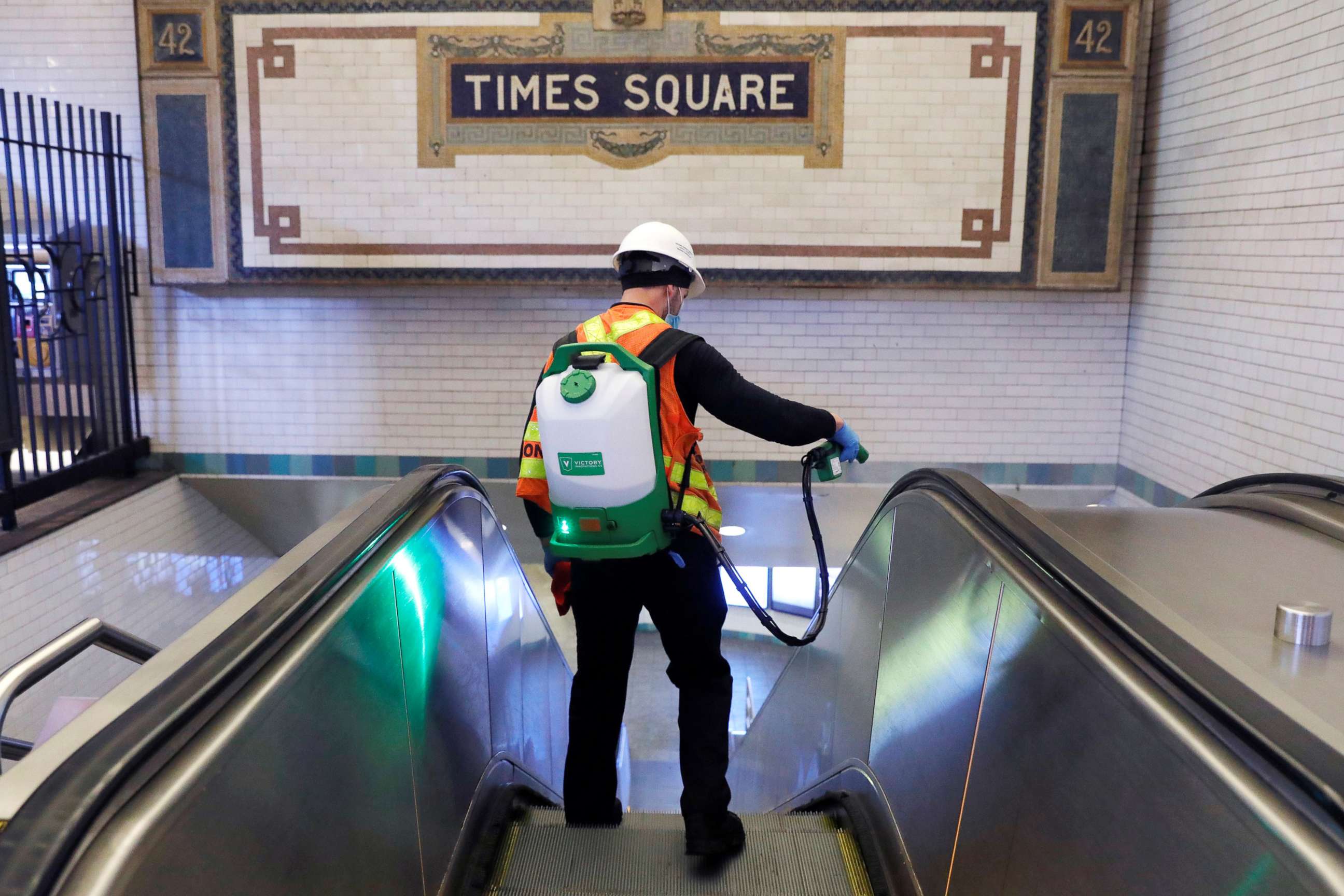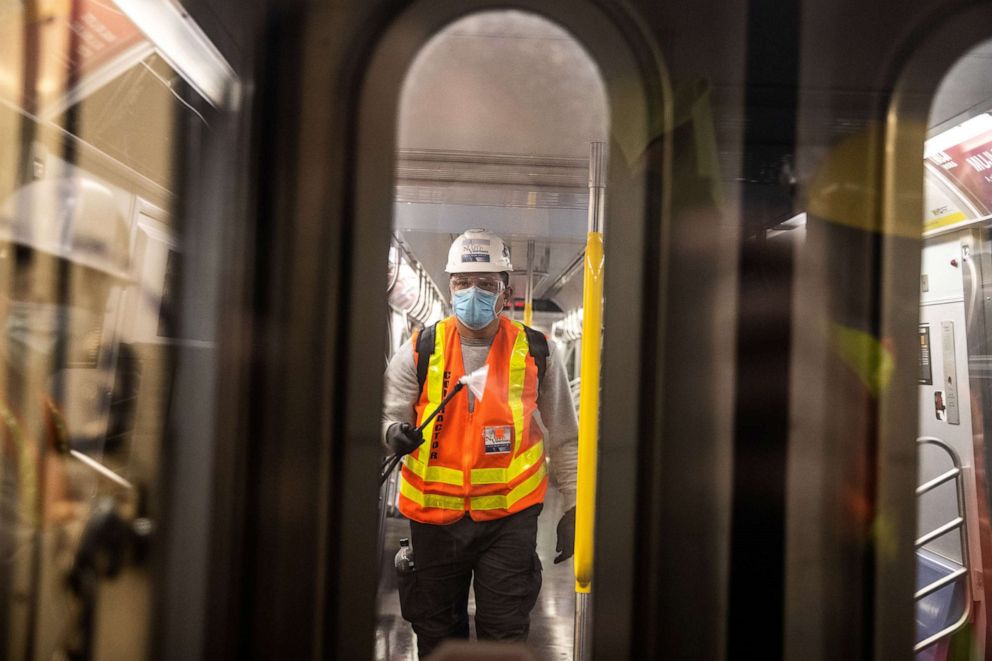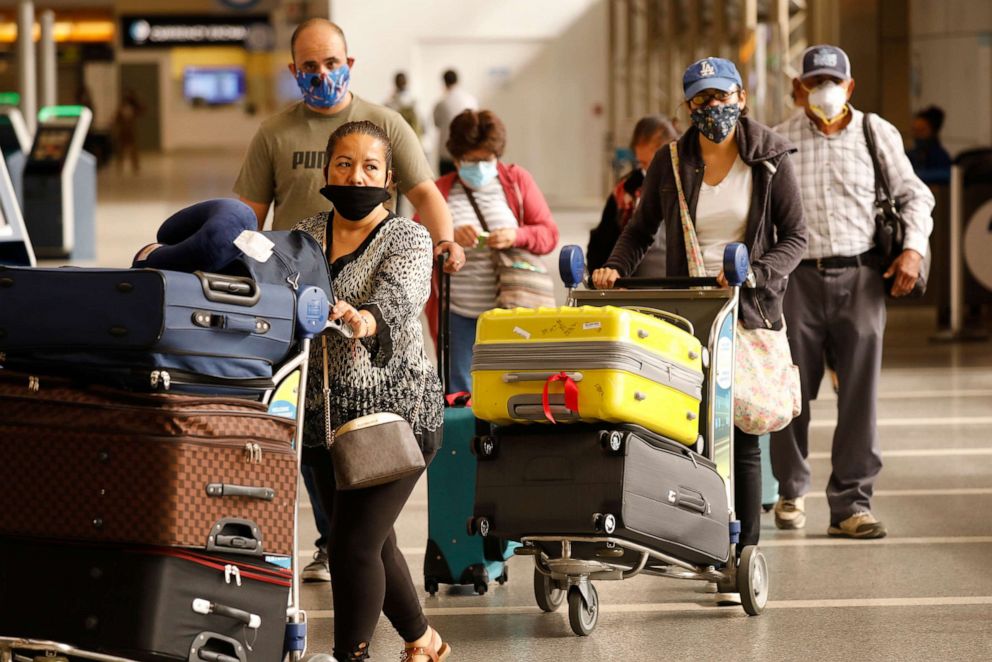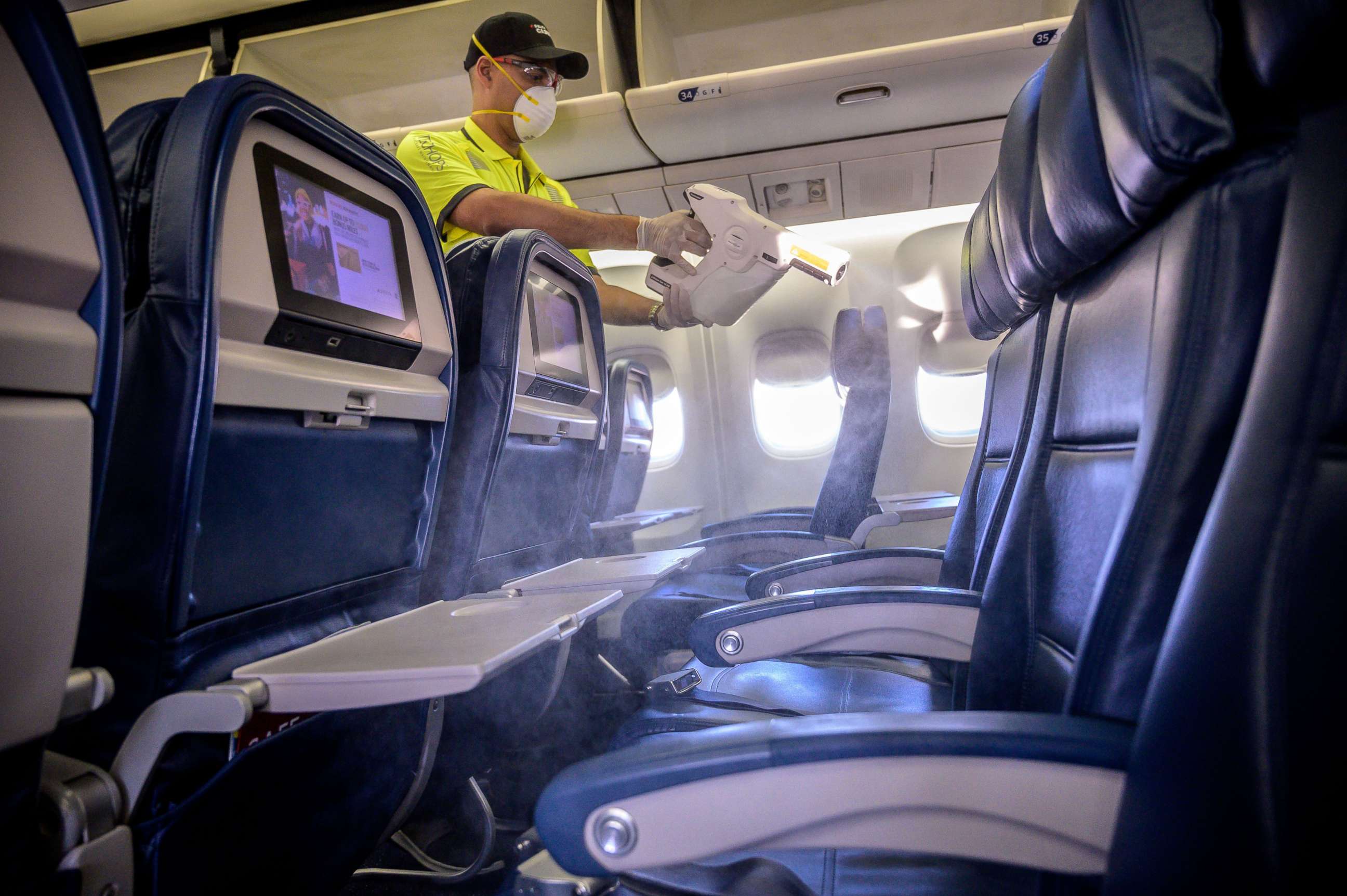In a spray of fog, hopes for safer commutes and travels amid coronavirus
From subways to planes disinfectants and microbials could play a leading role.
In a world where hard surfaces could play host to a germ that could potentially kill you, experts say one key to fighting the coronavirus is keeping those places clean. Plastic counters and trays, stainless steel handrails, banisters -- all those places people touch frequently without thinking about it, they've all taken on a more perilous light.
So one of the signature images of the new normal from long-distance travel to the daily commute is likely to be the technician in protective gear, spray gun in hand, slight fog of chemical mist all around.
But what does it all mean? What’s in that mist? And how safe is the traveling and commuting public really going to be as empty planes and trains give way to crowds of uneasy people, face masks on, just trying to get where they need to go?
The answers are critical for when America re-opens enough to get traveling again, and at least in part they lie in some of the ongoing efforts to directly target the microscopic threat.
“If you’re going to start taking public transportation, you’re going to start violating that social distancing principle,” said Dr. Robert Quigley, senior vice president and medical director for the travel risk consulting firm International SOS. “We know the virus exists on inanimate objects, like tray tables and armrests… We need to take measures that will at least be somewhat protective when we are unable to social distance.”

Last year, over 900 million passengers traveled on U.S. airlines, and there were nearly 1.7 billion riders just on New York City buses and trains combined -- evidence of an unprecedented sanitation challenge for a nation still grappling with a pandemic.
In an effort to get ahead of the problem that would come with re-opening, New York City’s Metropolitan Transportation Authority (MTA) announced it is trying out three antimicrobial coating products that are supposed to create protective barriers on surfaces that kill germs as part a pilot program for buses, trains and transit control rooms.
“Antimicrobial coatings are potentially the new breakthrough in infection control,” said Charles Gerba, an environmental virologist at the University of Arizona, who studies the spread of diseases. “The idea that anytime a surface gets contaminated, it starts killing the virus -- that’s the big advantage. The problem with traditional disinfectants is, as soon as you let everyone back in, the area is all contaminated again.”
Antimicrobial coatings are designed to protect surfaces for long periods of time and after repeated touching, Gerba said. They are already used in some densely packed foreign cities like Hong Kong and Singapore.
Gerba said he recently tested an antimicrobial coating product from Allied BioScience, and the results made him hopeful. He said his research team intentionally contaminated stainless steel surfaces with “a million viruses" after the surfaces had been coated with the antimicrobial two weeks earlier.
“Within 10 minutes, the number of viruses was reduced by more than 90%; within two hours, more than 99.9%,” said Gerba, who performed the outside tests for Allied BioScience using a different virus from the coronavirus family.
SARS-COV2, the virus that causes the COVID-19 disease, was not one of the viruses applied to the coating, but current federal guidelines don’t require specific testing against SARS-COV2. If a product can show it is able to kill tougher viruses than the coronavirus, officials at the Environmental Protection Agency said they are confident the product would be effective in combating SARS-COV2.
Tune into ABC at 1 p.m. ET and ABC News Live at 4 p.m. ET every weekday for special coverage of the novel coronavirus with the full ABC News team, including the latest news, context and analysis.
The MTA declined to disclose which specific products are being tested on the subways and buses. Agency spokeswoman Amanda Valdes told ABC News the MTA is committed to daily sanitization and is examining any product that might make the transit system safer.

Looking to the skies, Allied BioScience officials said they are negotiating with several major airlines but declined to comment further, citing ongoing discussions and conversations with the EPA and Food and Drug Administration as part of an effort to secure emergency authorization for wider use of their products.
Other companies that produce similar chemical treatments, like Microshield360 and Bioprotectus, said they are already being used by private aviation companies and are also in talks with the commercial airlines.
Gerba’s research on Allied BioScience's product is still undergoing peer review. His team, though, is simultaneously moving ahead testing other similar products even other treatments that can be applied to cloth and protective gear like medical masks, though it's believed to be more difficult for the virus to be transmitted on cloth.

While major airlines are still exploring the prospect of using antimicrobial coatings inside their jets, almost all are using surface disinfectants dispersed by electrostatic sprayers to kill germs on the spot.
“We have eight minutes to do the whole plane,” said Jeremiah Gray, the chief operating officer of EvaClean, whose product is used by Delta Airlines on the planes and at the gates and inside terminals. “It is a testament to the efficiency of our product and the ability to disinfect rapidly.”
The disinfectant is dispersed in a mist via industrial sprayers that release “charged droplets,” which can magnetically attach themselves to surfaces, allowing for more efficient and even coverage, Gray said.
In April, Delta released video of cleaners using electrostatic sprayers to disinfect its planes in an effort to assure customers the product offers a “quick drying process” that makes it “immediately safe to breathe on board.”

Two other major U.S. air carriers, United and American, also told ABC News they are using surface disinfectants and electrostatic spraying to enhance cabin cleanliness. American said it is using a product called BactroKill, but United declined to identify the product it uses.
While experts insist disinfecting will be key to keeping the pandemic under control once stay-home policies are relaxed, they also caution the chemicals being deployed have to be safe.
EvaClean’s chemical cocktail, for instance, is manufactured by a separate company, Kersia. Senior Kersia executive Mark Hodgson told ABC News its product is registered by the EPA as both safe for people and effective for killing the toughest of viruses.
Experts at Healthcare Without Harm, an organization that focuses on environmentally sound medical practices said they have concerns the push for widespread disinfecting could lead to broader use of chlorine, an irritant that can cause respiratory, skin and eye problems.
Susan Wilburn, an environmental and occupational expert with the organization said, “we encourage airlines to use the least toxic effective method, which sometimes is not a chemical but soap and water.”
Other health experts also said there are concerns with the use of cleaning chemicals that could put people at risk and suggested the best way forward might be additional time after cleaning and before people are allowed to board planes or trains.
“Disinfecting from COVID-19 is the priority and so [travelers] should be happy that the airlines are doing that,” said Dr. Peter Orris, a leading occupational and environmental health authority at the University of Illinois Hospital and Health Sciences System. “On the other hand, some of these disinfectants can be irritating to the upper respiratory tract and people with asthma are more sensitive to this kind of irritation. So best practice is to disinfect and then let it set aerating for a while.”
Dr. Jay Bhatt is a practicing internist, an Aspen Health Innovator Fellow and an ABC News contributor.
What to know about the coronavirus:
- How it started and how to protect yourself: Coronavirus explained
- What to do if you have symptoms: Coronavirus symptoms
- Tracking the spread in the U.S. and worldwide: Coronavirus map




